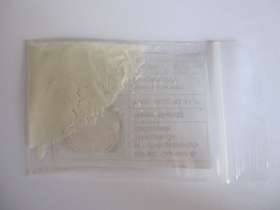
With a binding affinity of 0.468 nM at CB1 and 0.633 nM at CB2, 5F-PB-22 operates as a complete agonist. The results of a pilot investigation using isotope ratio mass spectrometry to profile the synthetic cannabinoid receptor agonist 5F-PB-22 (5F-QUPIC, pentylfluoro-1H-indole-3-carboxylic acid-8-quinolinyl ester) are described in this work. It concentrates on the isotope ratios of 13 C, 15 N, and 2 H, which are measured with an elemental analyser (EA) and a high temperature elemental analyser (TC/EA) connected to an isotope ratio mass spectrometer (IRMS). receptors for id
The extraction of 5F-PB-22 from herbal material, a fast clean-up method, or preparative column chromatography had no effect on the isotope ratios, as demonstrated by a sample of pure material of 5F-PB-22. In addition, 5F-PB-22 was isolated from 14 different herbal mix samples (“Spice goods” from police seizures) and analyzed using IRMS, providing three clusters including 7, 5, and 2 samples, which were distinguished by their isotopic composition. Herbal mixtures in each cluster are thought to have been made from distinct batches of 5F-PB-22.

The synthetic cannabinoid 5F-PB-22 (1-(5-fluoropentyl)-8-quinolinyl ester-1H-indole-3-carboxylic acid) is studied experimentally and theoretically in this paper. Raman and surface-enhanced Raman spectroscopy (SERS) spectroscopies were used to analyze the molecular vibrations of 5F-PB-22. Parallel quantum chemical calculations using the hybrid B3LYP exchange-correlation functional coupled with the standard 3-21G basis set were used to determine the geometrical and vibrational characteristics of 5F-PB-22 and to predict the molecule’s adsorption geometry on the silver colloidal surface.
A 532-nm laser line and a hydroxylamine phosphate reduced silver colloid as the SERS substrate were used to record the SERS spectra of 5F-PB-22. By comparing the DFT computed spectrum to the SERS and Raman spectral bands, they were assigned. A self-aggregation spectrum was achieved, but a two-step process was created to obtain a spectrum with NaCl as the aggregating agent. It was discovered that 10-mM NaCl can be employed as an aggregation trigger before adding 5F-PB-22 and then 20- to 100-mM NaCl to complete aggregation.
5F-PB-22 was easily discovered at 2.12 108 M using this method. It is proposed that the quinoline moiety of the molecule lies in a preponderant parallel orientation to the silver surface, with the plane of the indole ring being perpendicular to the surface, based on a predicted molecular adsorption geometry from the calculated molecular electrostatic potential and the SERS spectrum. Surface coverage by 5F-PB-22 and the presence of Cl influence molecule orientation.


